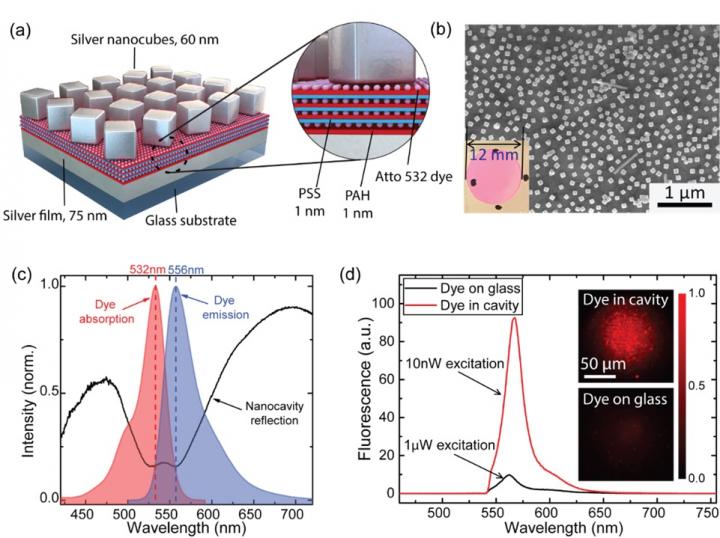Nanostructured thin film works over an unprecedented centimeter-scale area

Credit: Maiken H. Mikkelsen, Duke University
WASHINGTON — Researchers have created a new plasmonic metasurface that achieves record high light efficiency over the entire centimeter-scale metasurface. The advance makes the new nanostructured thin film practical for use in a variety of applications from light-based communication to fluorescence-based biosensing.
“The major obstacles for using plasmonic structures for practical applications is that they are either too inefficient or their nanoscale properties aren’t easily scalable to larger sizes,” said research team leader Maiken H. Mikkelsen from Duke University. “We designed and optimized a plasmonic metasurface that overcomes both of these limitations.”
In Optica, The Optical Society’s (OSA) journal for high impact research, Mikkelsen and colleagues describe how they designed nanostructured metasurfaces that boost the intensity and speed at which light is absorbed and emitted as fluorescence through surface plasmon resonance. Surface plasmon resonance occurs when certain wavelengths of light interact with free electrons at the interface of a metal and an insulator, or dielectric, surface.
“Our work shows that plasmonic structures can be very useful for enhancing both absorption and emission of light, not just from tiny nanocavities but over large wafer-scale areas,” said Mikkelsen. “This could be useful for ultrafast optoelectronics devices used in communications applications and could also increase the sensitivity of fluorescence-based biosensors.”
Faster light emission
To make the new metasurface, the researchers created a nanostructure that sandwiched fluorescent dye molecules between a gold film and 100-nanometer-wide silver cubes. When light hits this structure, it excites localized surface plasmons, which are collective oscillations of free electrons in the metal. This enhances the electromagnetic field around the dyes, causing them to emit light very quickly after being excited by the incoming light.
By putting just 10 nanometers between the film and the nanocubes, the researchers were able to dramatically increase the spontaneous emission rate of the entire metasurface wafer. To increase efficiency even more, they used multiple layers of dye.
“With our new design, there’s no need to cherry-pick the perfect nanostructure because the whole metasurface is efficient,” said Mikkelsen. “It can also be used to absorb light from large incidence angles and re-emit in a narrower cone at high speeds.”
Unprecedented efficiency
Tests of the new metasurface showed that it exhibited record high overall efficiency of about 30% for converting the incoming excitation light into emitted fluorescence. The nanoscale structures also maintained an ultrafast light modulation rate of more than 14 GHz across the full centimeter-scale metasurface, which has never been demonstrated before. For communication applications, faster light modulation allows more data to be encoded into light signals at a higher rate.
The new metasurface could be useful for producing a stronger fluorescence signal that would enable new biosensing and imaging methods. It might also offer a route to faster LEDs that could provide a fast source of incoherent light and new types of detectors for optical wireless communication.
###
Paper: A. J. Traverso, J. Huang, T. Peyronel, G. Yang, T. G. Tiecke, M. H. Mikkelsen, “Low-loss, centimeter-scale plasmonic metasurface for ultrafast optoelectronics,” Optica, 8, 2, 202-207 (2021).
DOI: https:/
About Optica
Optica is an open-access, journal dedicated to the rapid dissemination of high-impact peer-reviewed research across the entire spectrum of optics and photonics. Published monthly by The Optical Society (OSA), Optica provides a forum for pioneering research to be swiftly accessed by the international community, whether that research is theoretical or experimental, fundamental or applied. Optica maintains a distinguished editorial board of more than 60 associate editors from around the world and is overseen by Editor-in-Chief Prem Kumar, Northwestern University, USA. For more information, visit Optica.
About The Optical Society
Founded in 1916, The Optical Society (OSA) is the leading professional organization for scientists, engineers, students and business leaders who fuel discoveries, shape real-life applications and accelerate achievements in the science of light. Through world-renowned publications, meetings and membership initiatives, OSA provides quality research, inspired interactions and dedicated resources for its extensive global network of optics and photonics experts. For more information, visit osa.org.
Media Contacts:
Aaron Cohen
(301) 633-6773
[email protected]
Media Contact
James Merrick
[email protected]
Related Journal Article
http://dx.





